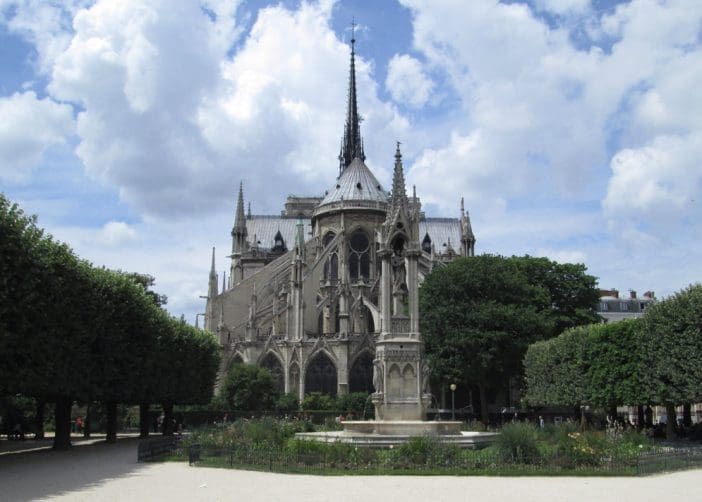
Cathédrale Notre-Dame de Paris – 2014
by Paula Johnson
April 15th means tax-day to most Americans in the US. However, April 15, 2019, is the devastating day in Paris when Notre Dame Cathedral burned.

The cathedral has been one of the must-sees when visiting Paris, whether for the first time or the 100th time. The burning in 2019 was not the first destruction to the famed building which was begun in the 12th century.
Notre Dame Cathedral in Paris took about 300 years to build. Within those centuries several architectural styles came and went. Thus, its construction exemplifies French Gothic, Renaissance and Naturalism.
An example of this is that the original design did not include flying buttresses. However, as the cathedral developed higher, the walls began to push outward and fracture. So, these supports were added to the plan; making it among the first in the world to have this design.
Notre Dame originally was begun to replace the ruins of two basilicas on the same location. The central spire became instable and was removed in the 18th century. Then, replaced 100 years later. Over time, damage and deterioration took their toll on the cathedral.
The French Revolution in 1786 created a great deal of damage to Notre Dame. To prepare for Napolean’s self-crowning as emperor in 1804, the cathedral was restored adding neo-Gothic to the overall design.
Not only is the cathedral important and loved for its architecture, but is home to artwork, furniture, and other numerable invaluable items.
Thus, following the burning, hundreds of companies, and artisans from all over the world pledged support, both monetary and artistic. Special organ builders are restoring the 8,000 pipes and 115 stops in its great organ, the largest in the world.
In 2014, I had the fortunate opportunity to join the Edwardsburg High School French class for its trip to Italy and France. Among the many memorable sites was the visit to Notre Dame Cathedral. The front view is famous, but I fell in love with the backyard. It is there that the spires and construction of the epic building can be really seen.
Great care has been taken to recreate and totally replicate the 19th century spire that replaced the original 12th century one. Though still encased in scaffolding, the new spire was placed December 16, 2023, and the opening of the 860-year-old edifice is still on schedule for 2024 (coming up).
For me, the history person, the visit wasn’t just the beautiful cathedral – inside and out, nor the statue commemorating Charlemagne. I was intrigued by the ancient city lying beneath the parvis (court) outside the entrance.
As in many European cities, cities were built on cities or foundations of ancient cities. Beneath the courtyard in front of Notre Dame lie relics of buildings, foundations, and signs of human life from the Middle Ages, pre-Roman times, and even 500,000 years ago (Paleolithic).
Also, directly in front of the cathedral entrance is Point Zero & The Paris Meridian. This marks the exact centre of Paris. It is from this point that one can accurately measure the distance to other European places.
The Paris Meridian was the accepted meridian for map and cartography until 1884. There grew much concern for the accuracy of the meridian. The Greenwich meridian became a long-standing rival. It wasn’t until the International Meridian Conference of 1884 in Washington D.C. that the Greenwich meridian was accepted around the world, with French exceptions of time and navigation that eventually discontinued by 1914.
If you ever want to read a fascinating book about the building of a cathedral (warning – not short…over 1000 pages), Ken Follett’s Pillars of the Earth* is worth the read.
The reopening of Notre-Dame Cathedral in Paris is announced for the 8th December 2024. A Te Deum is planned for 15 April 2024, exactly 5 years after the fire.
–https://parisjetaime.com/eng/article/notre-dame-the-current-situation-a741
*Copies of Follett’s PIllars of the Earth are available at the Marcellus Township Wood Memorial Library and Cass District Library.

Leave a Reply
You must be logged in to post a comment.